Dehydrating is the most expensive way to preserve eggs, but only because the initial investment of a dehydrator will be anywhere from $65 to $175. We own three dehydrating machines now.
We upgraded with each purchase, and have not been unhappy with any of the NESCO machines that we own. Having three functioning machines makes putting up the garden, barnyard, apothecary, and foraged harvest a lot quicker alone and when canning on the stove as well.
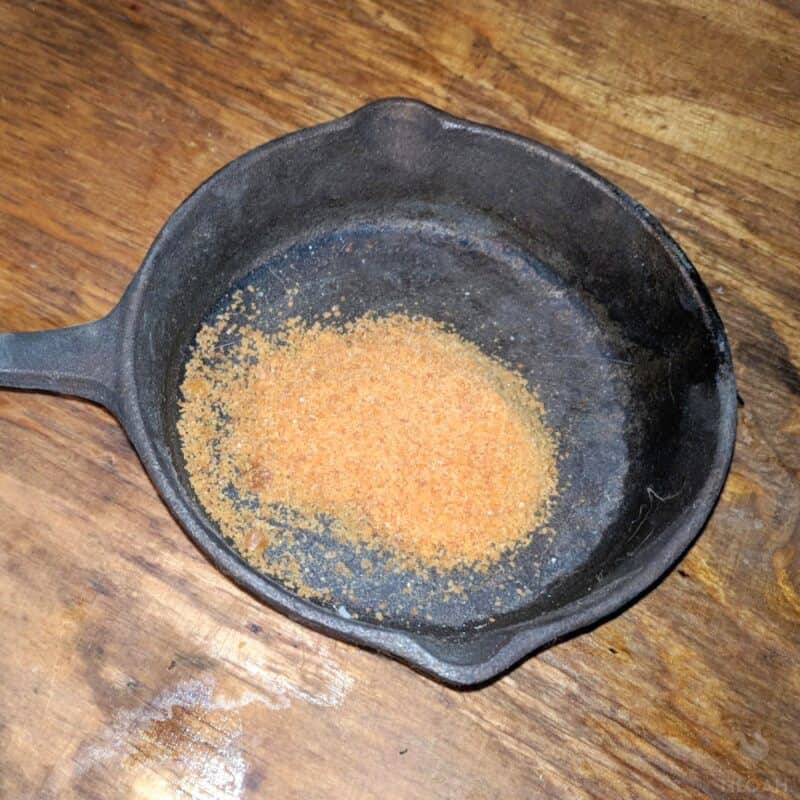
When compared to the cost of buying long-term storage powdered eggs, a dehydrator is actually quite a bargain. Depending upon the brand of powdered eggs purchased, they can range between $11 for as many ounces to $15 for a five pound bag.
The process for dehydrating eggs commercially is a lot more involved than drying with a residential machine on your own kitchen counter.
Commercially, a spray drying technique is often used to liquify the pasteurized eggs. They are then sent through a spray nozzle type device into a heated tank. Once inside the tank the water evaporates and the solid egg powder collects at the bottom of a containment tank.
When you compare home dehydrated eggs and commercially dried and powdered ones, you will likely notice a difference in color.
This change in hue is caused by a de-sugaring process at the manufacturing plant that is conducted to help maintain both the appearance, and supposedly the quality of the egg during the preservation process.
Do Dehydrated Eggs Lose Nutrients?
The answer to whether dehydrated eggs lose nutrients depends on how you view the process of dehydration. Dehydration simply removes water from the food item and does not necessarily reduce its nutritional value.
On the contrary, some experts argue that removing water actually boosts the nutritional value of dehydrated foods because most of their mass is composed of vitamins, proteins, or other key nutrients. In addition, dehydration increases the shelf-life of a food item, meaning that it takes longer for its nutrient content to degrade.
Still, it is important to keep in mind that heating or drying any food can result in some nutrient loss due to oxidation and exposure to air. That said, as long as you store your dehydrated eggs properly and consume them within a reasonable time-frame, they will retain most of their nutritional qualities – any nutrient loss will be minimal.
How Do You Eat Dehydrated Eggs?
You can eat dehydrated eggs just as you would eat fresh eggs in just about any way (perhaps, except, hard boiled or sunny side up!).
In fact, eating dehydrated eggs is a great way to enjoy scrambled eggs at any time. All you need to do is add water to rehydrate your scrambled eggs and then use them as you would a fresh egg—just crack the mixture into a bowl and whisk in some milk, cheese, salt and pepper (if desired).
You can also use your dehydrated scrambled eggs to make an omelet; just follow the same recipe you would use for a regular omelet but with whole eggs instead of scrambled. However you decide to eat your dehydrated eggs, it’s sure to be delicious!
How Do You Dehydrate Raw Eggs for Long Term Storage?
There are two ways to dehydrate eggs at home, the wet-dry method, and the cook-dry method.
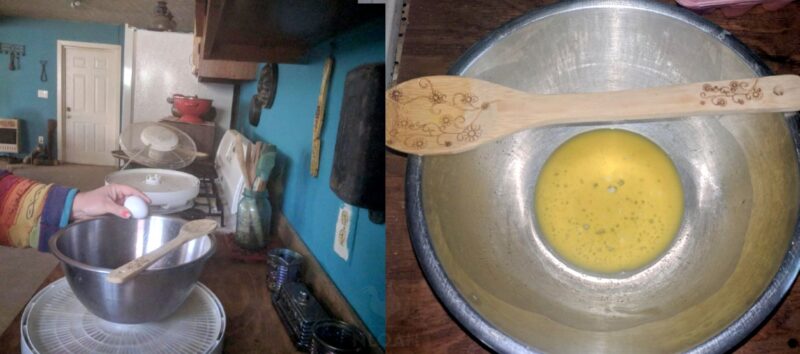
Cook-Dry
In the cook-dry egg preservation method, the eggs are scrambled first, without adding any milk or water, and then dehydrated for about 4 hours on 145F (62 C) heat until they become brittle.
A mesh dehydrator tray liner must be used to prevent the drying eggs from falling through the slits in the machine trays. A solid plastic tray liner can be used, as well, but is not typically necessary since you are dealing with a solid food item.
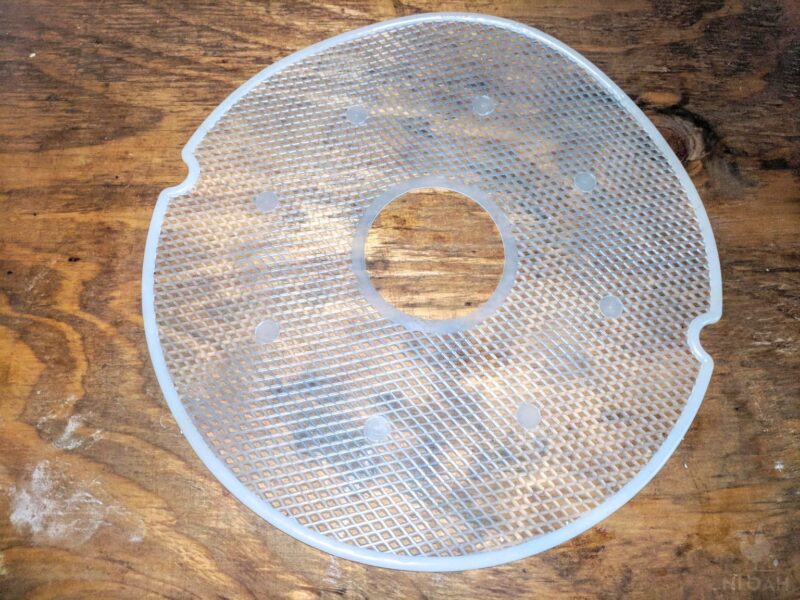
Most dehydrator machines come with a couple of mesh tray liners, but not always. If you do not have a machine, and are browsing models online or in a store, read what is included inside the box carefully.
There is almost always an insert in the box or included in the instruction manual directing you to a website to order both mesh and solid tray liners. Amazon also sells the insert for all machine models the online store carries.
Once the cook-dry eggs are brittle, they are then either manually (with a mortar and pestle or similar kitchen tools) pounded into a powder or placed in a either a blender or food processor and pulverized into a powder:
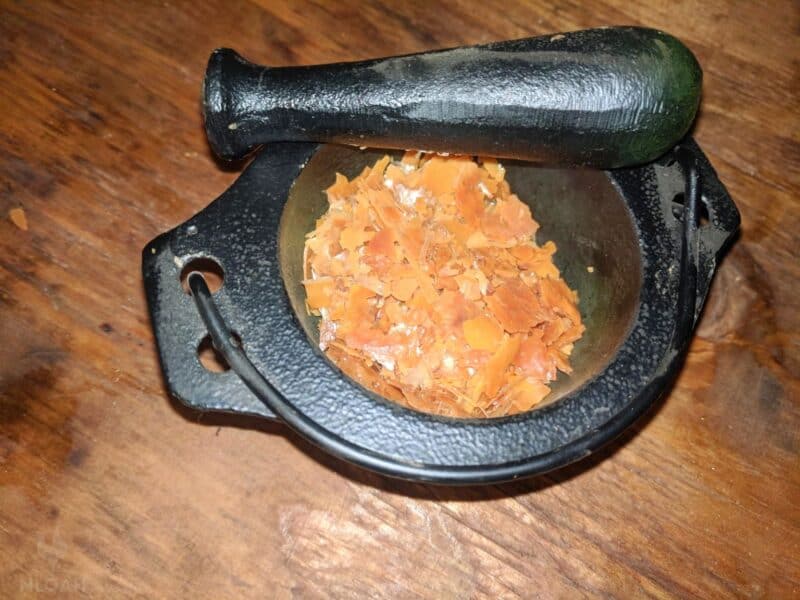
I only tried the cook-dry egg preservation method one time. The eggs turned out great, but I felt the added step was not necessarily from either a quality or longevity standpoint, and the smell of the cooking eggs without the benefit of milk and water, as well as a more pungent scent during the dehydration process, were not pleasant ones.
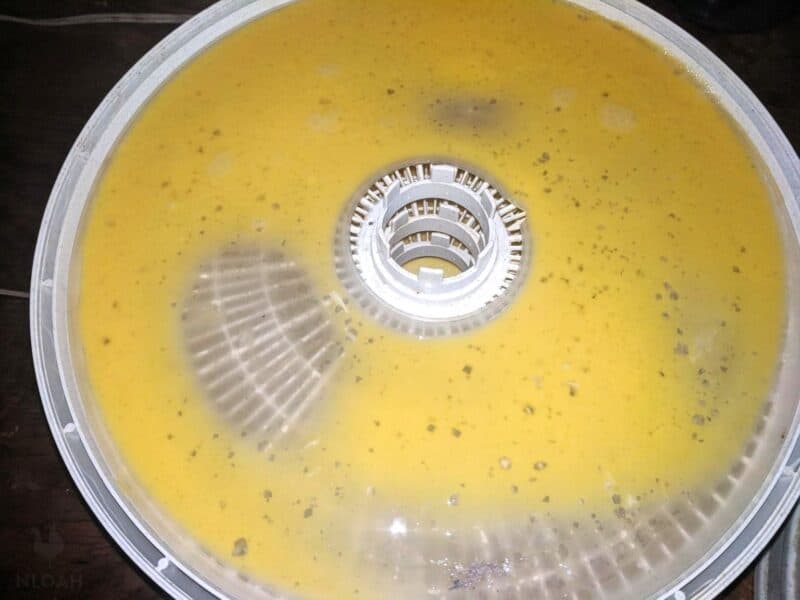
Wet-Dry Method
This method is very similar to the cook-dry method, with the stove top scrambling omitted, and a long drying time required. The beaten raw eggs are dried at the same 145F / 62C (or up to 160F / 71C if your dehydrator machine is capable) for 10 to 12 hours.
A solid plastic tray liner must be placed in the machine to hold the beaten raw eggs. It’s essential that the machine be placed on a firm and level surface, or the liquid eggs, despite their thickness, will pool at one end, or possibly pour out over the liner and down onto other trays – causing them to overflow too.
Once the dehydrated eggs resemble thin peanut brittle and are solid (albeit somewhat oily) to the touch, they are done.
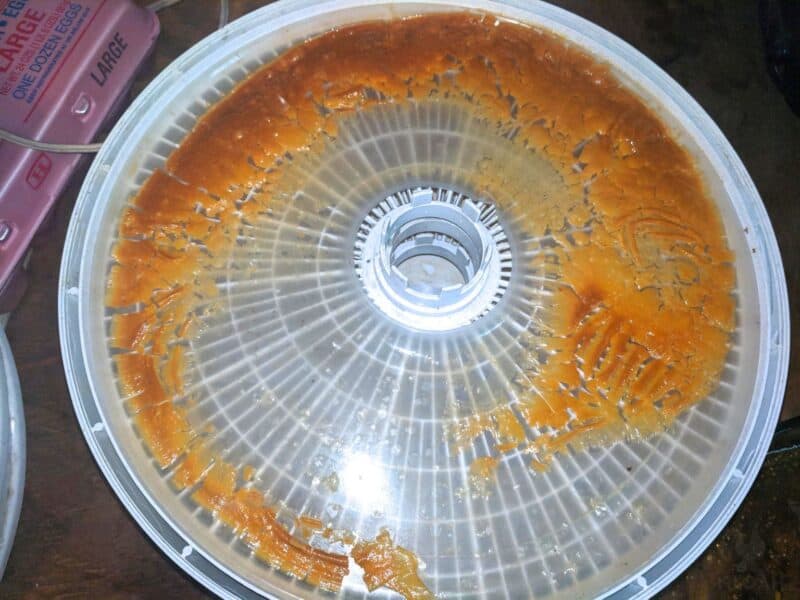
You can store the dehydrated eggs in simple thin chunks, or blend them into a powder. I prefer to powder the eggs because they take up less space to store and are far easier to measure when they need reconstitute – re-hydrated.
How to Store Dehydrated Eggs
No matter if you choose the cook-dry method or the wet-dry method, the eggs must be stored in an airtight container in a cool, dry place to ensure they remain shelf-stable.
You can keep them at room temperature, but I recommend keeping them at slightly cooler temps (though they don’t need to be kept in the fridge and certainly not in the freezer).
I recommend storing them in small Mason jars to limit the number of times the preserved eggs are exposed to air and moisture when the lid is removed. Every time the dehydrated eggs are unsealed, their shelf life decreases by leaps and pounds.
If you have a vacuum sealer machine, you can use the bags that come with it to store various amounts of preserved powdered eggs that you intend to use all at once, or use the Mason jar lid sealer attachment to vacuum seal the lids more tightly onto the glass container.
How Long Will Dehydrated Eggs Last?
When dehydrated and stored properly, farm eggs can be shelf stable for at least one year on a low end estimate up to 10 years.
The longevity is dependent on how they are dehydrated and stored, but on the low end estimate, properly dehydrated farm eggs should stay shelf-stable for a minimum of one year if sealed in an airtight container in a cool and dry place.
This makes dehydrated eggs great for camping or traveling where access to refrigeration may not be guaranteed.
Helpful Hints
- One tablespoon of powdered eggs equals approximately one large egg.
- I usually spread a mixture of about six large brown eggs onto each plastic dehydrator tray liner.
- It takes about 30 eggs to make four cups of dehydrated powdered eggs.
- To reconstitute the dehydrated eggs, mix them at a 2 to 1 ratio of powdered eggs to water or 1 tablespoon of eggs to 1 teaspoon of water.
- I always use lukewarm water to reconstitute eggs, it seems to work best.
- Some homesteading pals have used milk to reconstitute eggs for scrambling because they maintain their taste better. I tried using milk twice, and had horrible texture and tasting results.
- You can separate the yolks from the whites before blending the eggs together if stockpiling separated eggs for baking and cooking is a priority.
- If you are too concerned about potential salmonella poisoning caused by dehydrating eggs around 145 °F / 62 °C, you can also spread the blended mixture onto a cookie sheet and dry them in an oven at 165 °F / 73 °C (if your oven goes that low) for 10 hours. The one time I tried this method I was able to spread a mixture of 18 large brown eggs onto the three baking sheets that would fit into my oven.
- You can choose to add other ingredients like spices and herbs when you dehydrate your egg mixture, but don’t add things like milk or cheese. Again, these can be used for reconstitution, but shouldn’t be involved early on – keep things simple!
That’s about it! Do you have your own tips for dehydrating eggs? Are you doing anything different? leave us a comment below, and BE SURE TO PIN THIS ON PINTEREST using the image below:
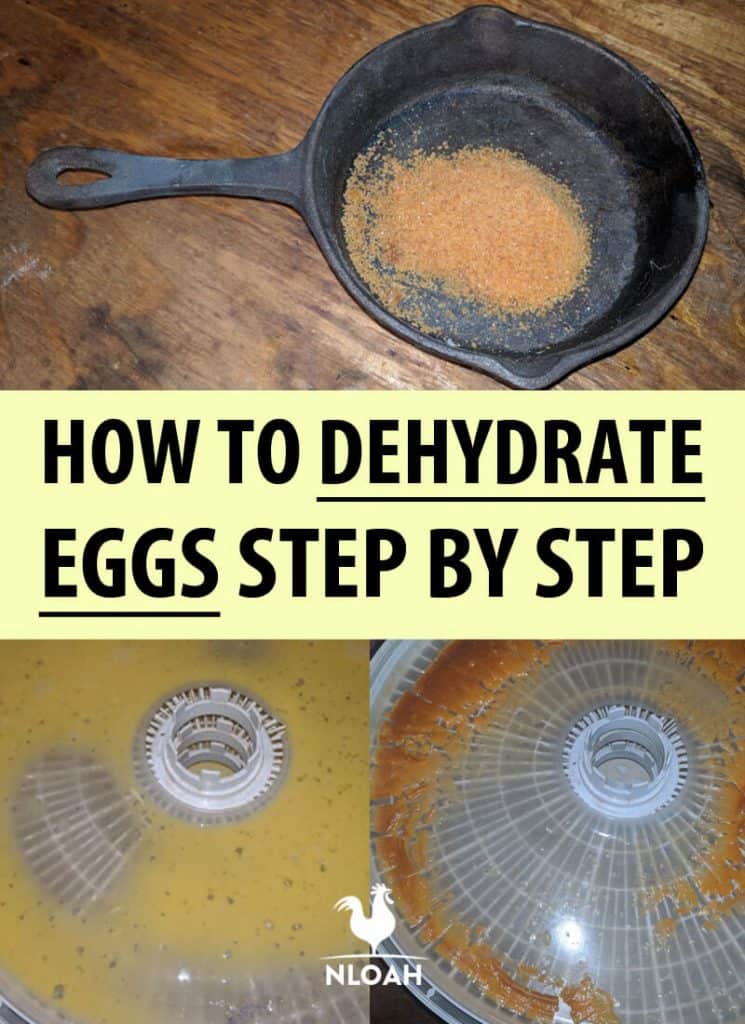

Tara lives on a 56 acres farm in the Appalachian Mountains, where she faces homesteading and farming challenges every single day, raising chickens, goats, horses, and tons of vegetables. She’s an expert in all sorts of homesteading skills such as hide tanning, doll making, tree tapping, and many more.

I’m very excited to be dehydrating raw eggs. This is my first time. I beated 1 dozen store bought eggs & placed it on a metal rack with tin foil. And I have set at 135 for 8 hours, I’m using a newer Samsung over with a dehydrating setting. Is it safe to do raw eggs in the oven? Should I have scrambled them first?
Once they are in storage. Can you just reheat them at at high temp to kill salmonella when your using them later for cooking? If I’m making eggs with raw powder just cook them well?
What trays do you recommend?
I have been using the cook-dry method. Because I use it for camping, I will add salt and pepper while I cook them. This way it saves me the hassle of bringing s/p with me.
Joshua when you reconstitute them, do you make scrambled eggs? I’ve never even heard of this, so just trying to get my bearings. Thanks.